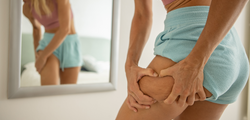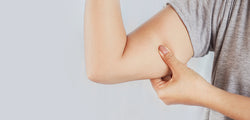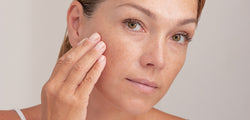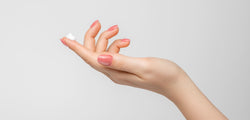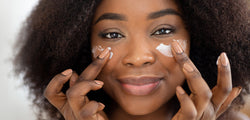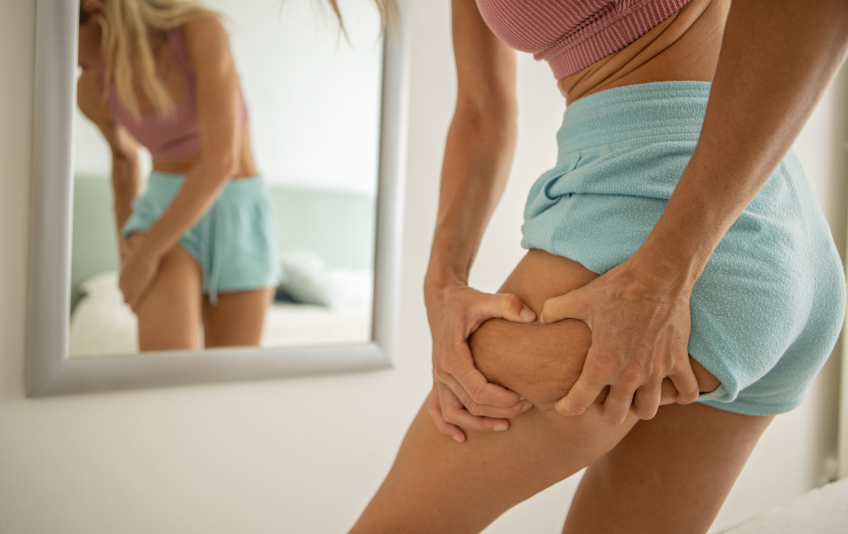
Stretch Marks vs. Cellulite - What's Really the Difference?
- Stretch marks and cellulite are two completely different skin conditions, although most people have a penchant for mistaking one for another.
- Stretch marks typically occur when skin is stretched rapidly due to weight gain, growth spurts, or pregnancy.
- Cellulite, on the other hand, is a condition in which the skin appears dimpled or lumpy, usually on the buttocks and thighs.
Table of Contents:
The cellulite vs. stretch marks debate has, without a doubt, dominated the aesthetics and body appeal head space for generations now. But did you know that both stretch marks and cellulite are usually considered medically harmless, apart, of course, from the hefty blow that they usually deal our self-esteem? That being said, no one looks forward to the day their body is riddled with stretch marks and cellulite, especially not in the current generation that is unreasonably obsessed with looking great both in person and behind a camera lens. Granted, cellulite and stretch marks are hardly photogenic. But do you really know the difference between the two? What's the difference between cellulite and stretch marks? Well, this informative but incredibly enthralling excerpt attempts to get to the bottom of the cellulite stretch marks debacle.
It's a Normal Part of Life
Even before delving deep into the stretch marks vs. cellulite fiasco, you ought to be cognizant of the fact that both cellulite and stretch marks are common skin conditions that occur due to various factors such as genetics, weight changes, hormonal changes, and more. They are definitely not harmful or dangerous and are a normal part of many people's lives. Nonetheless, while they are not harmful (at least not medically), some folks (women especially) may find them cosmetically unappealing and seek treatment to reduce their appearance. If this sounds like you, you have just stumbled on a treasure trove of information that may finally help you get the cellulite marks monkey off your back.

The Causes of Cellulite and Stretch Marks
At this juncture, you might be wondering, is cellulite stretch marks? No, definitely not! Cellulite and stretch marks are two different skin conditions with vastly different causes. Here's a quick primer on the list of stretch mark vs cellulite causes.
Cellulite is mostly caused by:
- Genetics
- Hormonal changes
- Poor diet
- Dehydration
- Inactivity
- Age
While stretch marks are usually a result of:
- Rapid weight gain or weight loss
- Pregnancy
- Genetics
- Hormonal changes (such as puberty or hormone replacement therapy)
- Certain medications (such as corticosteroids)
Truth be told, the exact causes of these skin conditions are not fully understood, but they are associated with the underlying structure and function of the skin and tissues. The following two sections attempt to dig deeper and shed some crucial light on the main culprits behind stretch marks or cellulite appearance.
What Causes Stretch Marks?
1. Rapid Weight Gain or Weight Loss
Rapid weight gain or weight loss can cause stretch marks due to the sudden stretching of the skin. You see, when the skin stretches too quickly, it causes the skin’s middle layer (i.e., the dermis) to tear, allowing the skin’s deeper layers of skin to become visible and form stretch marks. This is mainly because the dermis contains fibers that allow your skin to stretch as your body grows.
Evidently, rapid weight gain is more likely to cause stretch marks than rapid weight loss, as any rapid changes in the shape of the skin can result in stretch marks, even the shrinking of the skin caused by losing weight. Stretch marks typically occur when people lose or gain weight quickly, as they are essentially a scar caused by a breakdown in collagen and elastin, two proteins that give our skin its elasticity and strength.
2. Pregnancy
A ballooning pregnancy can trigger the appearance of stretch marks due to the rapid stretching of the skin that occurs as the baby grows. As the skin stretches, the collagen and elastin fibers that give skin its elasticity can break, causing the skin’s deeper layers to become more conspicuous. Besides, stretch marks are usually associated with pregnancy because hormones like cortisol and estrogen, which are typically secreted during pregnancy, reduce the activity and effectiveness of the collagen and elastin fibers in the skin. To reduce the appearance of stretch marks during pregnancy, it is imperative to keep your skin hydrated and moisturized using a well-formulated emollient like Maryann Hydrocare Cream. Additionally, eating a balanced diet rich in vitamins A and C can help promote having healthy skin during this phase.

3. Genetics
As unfair as it may sound on paper, genetics play a role in the likelihood of developing stretch marks. Some people may be more predisposed to developing them due to the genes they inherit from their parents.
Speaking of which, people with a family history of stretch marks may be more likely to develop them due to their skin's lower levels of collagen and elastin, which are responsible for keeping the skin firm and elastic. Similarly, women are more likely to get stretch marks than men due to their naturally thinner skin and hormonal shifts throughout the life cycle.
4. Notable Hormonal Changes
Here is the thing; hormonal changes can trigger the appearance of stretch marks due to the fluctuations in hormones that can occur during puberty, pregnancy, and menopause. These hormonal changes can cause the skin to become thinner and less elastic, making it more prone to tearing and stretching. During puberty, growth hormones such as estrogen and progesterone can inhibit collagen production and decrease the skin's elasticity. During pregnancy, for instance, hormones secreted at this phase are known to soften collagen fibers by decreasing the bonding between them, which consequently increases the appearance of stretch marks. Hormonal events such as pregnancy and puberty also cause changes in one’s overall shape or physique, leading to stretch marks on the breasts.
5. Medications
Certain medications, such as corticosteroids, can trigger the appearance of stretch marks by weakening the skin's collagen and elastin fibers. This weakening of the skin's fibers makes it more prone to tearing, which makes the deeper layers of your skin to surface and form stretch marks. In case you are wondering, corticosteroids are commonly used in inhalers to treat asthma and other respiratory conditions, but they can also be applied topically or taken orally. When using corticosteroids, it is strongly recommended to use the lowest possible maintenance dose and protect the skin from sun exposure to minimize the risk of skin atrophy.
What Causes Cellulite?
1. Genetics
Just like in stretch marks above, your genes could be the main culprit behind your cellulite-riddled stems as they usually dictate the structure of the connective tissue in the skin, making it more prone to fat accumulation and thus causing the appearance of cellulite. Certain genes, for starters, are required for cellulite development. Not to mention that genetic factors can be linked to a person's speed of metabolism (BMR), distribution of fat under the skin, hormones, age, and lifestyle. That being said, while the etiopathogenesis of cellulite is multifactorial and unclear, it is known to incorporate hormonal and metabolic factors, which genetics falls under squarely.
2. Poor Diet
Did you know that eating too much fat, carbohydrates, and salt and too little fiber can increase the risk of developing cellulite? You see, diets that are high in fat are known to create more fat cells, which can contribute to the appearance of these unsightly marks. Therefore, it is important to maintain a balanced, nutritious, and healthy diet to reduce the risk of developing cellulite. Eating a variety of fruits and vegetables, whole grains, lean proteins, and healthy fats also helps maintain a low body fat percentage, keeping cellulite at bay or at least making it less conspicuous.

3. Inactivity
Leading a sedentary lifestyle, aka inactivity, can contribute to the development of cellulite as it is associated with dehydration and changes in fat production, as well as decreased skin firmness due to lack of mechanical stimulation. In fact, studies have shown that those with less physically demanding jobs are more likely to develop more severe cases of cellulite than those who are constantly on the move. In other words, to prevent and treat cellulite, it is advisable to maintain a healthy lifestyle with regular physical activity and a balanced diet.
4. Age
Are you aware that aging can cause cellulite by weakening the skin's connective tissue, making it more prone to fat accumulation and thus causing the appearance of cellulite? You see, as we age, our skin loses its elasticity, and collagen production decreases, making it more difficult for the skin to maintain its structure and leading to a decrease in skin thickness. This decrease in collagen content in photoaged skin can be due to intrinsic or extrinsic aging caused by sun exposure makes it easier for cellulite to show. In fact, such intrinsically aged skin is usually characterized by dermal atrophy with a reduced density of hyaluronic acid, elastin, and collagen fibers which is synonymous with skin dimpling. Additionally, high estrogen levels can lead to increases in fat cells, further weakening the skin's connective tissue and allowing cellulite to appear.
5. Dehydration
Dehydration can cause a toxic buildup in the skin’s fat cells, making it difficult for the body to metabolize these future fat deposits. This buildup also contributes to the cottage cheese-like appearance of cellulite. Not to mention that dehydration causes thinner and weaker skin, which has a greater tendency to show cellulite.
Treatment for Stretch Marks and Cellulite
Admittedly, the cellulite and stretch marks treatment is not a walk in the park. Nevertheless, with the help of stretch marks and cellulite creams, and a couple of other lifestyle changes, you can, at the very least, minimize the conspicuousness of these fat rolls on your stems or arms.
Without further ado, here's how to get rid of cellulite and stretch marks.
- Topical creams and ointments: Products containing retinoids, hyaluronic acid, and vitamin C can help improve the appearance of stretch marks and cellulite by increasing collagen and elastin production in the skin. A perfect example of this would be Maryann’s Anti-cellulite Hot Cream which is a fat-burning and body-sculpting emollient that employs a barrage of incredibly effective ingredients such as caffeine and L-carnitine, in addition to the above-mentioned ones. In other words, apart from just banishing your stretch marks and cellulite, you can also look forward to noticeably youthful-looking skin.

- Microdermabrasion: This cosmetic procedure is one of the highly-effective cellulite and stretch mark removal methods. It involves removing the top layer of skin using a machine that sprays fine crystals over the affected area. Evidently, microdermabrasion can help improve the appearance of stretch marks and cellulite by increasing blood flow and promoting the growth of new skin cells.
- Laser therapy: This stretch marks and cellulite treatment typically involves using laser energy to stimulate collagen and elastin production in the skin. Laser therapy can help improve the appearance of stretch marks and cellulite by thickening the skin and improving its elasticity.
- Radiofrequency therapy: This treatment uses radiofrequency energy to heat the skin and stimulate collagen and elastin production. Radiofrequency therapy can help improve the appearance of cellulite by tightening the skin and reducing the appearance of dimples.
- Massage therapy: Massage therapy can help improve the appearance of cellulite by increasing blood flow, improving lymphatic drainage, and breaking down fatty deposits in the tissue.
- Exercise: Regular exercise, especially strength training and cardiovascular exercise, can help improve the appearance of cellulite by increasing circulation, building muscle, and reducing fat accumulation in the affected areas.
In Closing
In summary, treatment options for stretch marks and cellulite include topical creams, microdermabrasion, laser therapy, radiofrequency therapy, massage therapy, and exercise. The effectiveness of these treatments may vary or require multiple sessions.
FAQ SECTION
-
Does cellulite turn into stretch marks?
Cellulite and stretch marks are two different conditions. Cellulite is a bumpy, indented skin texture that some folks describe as resembling orange peel, while stretch marks (medically referred to as striae) are indented streaks or lines on the skin. While cellulite and stretch marks may be more noticeable in the overweight population, they can still develop in people of any size. There is no scientific evidence that cellulite can turn into stretch marks or vice versa. However, some natural remedies, such as exfoliation and coffee scrubs, may help reduce the appearance of both cellulite and stretch marks.
-
What does early cellulite look like?
Early cellulite is characterized by dimpled-looking contour alterations on the skin’s outer layer and is usually present in approximately 85% to about 90% of women who are past puberty. It typically begins to appear between the ages of 25 to 35, when estrogen levels start to decrease, leading to decreased circulation and a decrease in receptors in blood vessels and thighs. That said, people of normal weight can get early cellulite, regardless of age or gender.
-
Does cellulite cream get rid of stretch marks?
Cellulite creams can help reduce the appearance of stretch marks, but they are not a cure-all solution. Cellulite creams typically contain ingredients such as retinol or caffeine that can help reduce the appearance of stretch marks. Additionally, products specifically designed for stretch mark removal may prove to be more effective than cellulite creams.
-
What helps break up cellulite?
There are several treatments available for cellulite, including lifestyle and home remedies, acoustic wave therapy, laser treatment, subcision, vacuum-assisted precise tissue release, weight loss, exercise, laser cellulite reduction, non-laser treatments (radiofrequency, ultrasound, etc.), injectable treatments, eating more raw foods, losing a few pounds, massage the dimpled areas and laser therapy.
-
How do I flatten my cellulite?
Cellulite can be reduced through exercise, massage, and lifestyle changes. Exercise can help improve the appearance of cellulite by increasing muscle mass and speeding up fat loss. Specific exercises that target cellulite include squats, lunges, deadlifts, and leg lifts. Massage may reduce cellulite by improving lymphatic drainage and stretching out skin tissue. Additionally, lifestyle changes such as eating more raw foods, losing weight, quitting smoking, and reducing stress can help reduce the appearance of cellulite.
-
Can you get rid of cellulite once you get it?
Unfortunately, it may not be possible to completely get rid of cellulite once you have it. However, there are treatments available that may improve its overall appearance. These treatments include exercise, diet, laser treatments, and other in-office treatments recommended by dermatologists and plastic surgeons. Bear in mind that while these treatments may not completely eliminate cellulite, they can help make it less noticeable.
-
Do guys notice cellulite?
While some men may not notice cellulite, many do and are not bothered by it. In fact, you’d be surprised that many men cannot even “see” cellulite, the same way they can't “see” other physical changes such as a new haircut or dress, humorously, of course. Men appreciate the softness and warmth of a woman's skin, and some even have reported finding cellulite attractive. Overall, most men do not care about cellulite and view it as a natural part of a woman's body.
-
Will losing weight get rid of cellulite?
Losing weight may make cellulite less visible, but it won't go away completely]. You see, once a fat cell develops, it is yours for life, and you can only make it less noticeable. Cellulite is caused by weakened connective tissue due to hormones, lack of exercise and muscle tone, excess fat, and other factors. As such, while healthy dieting and exercise may reduce weight and tone muscles, neither can solve the problems of cellulite entirely. You have to integrate other methods of cellulite removal.
-
What foods cause cellulite on the legs?
Certain foods can contribute to the development of cellulite on the legs. These include processed meats and cheeses, canned soup, soda and sweetened beverages, barbeque sauce, cottage cheese, pizza, margarine and spreads, fried food, sugar, excess fat, and carbs, carbonated and caffeinated drinks, alcohol, dairy products, trans fats, and salt-rich foods. Eating a diet high in these foods can cause fat cells to enlarge and increase toxins in the body, leading to an accumulation of fluid which can cause cellulite.
-
At what body fat percentage does cellulite go away?
Cellulite can occur in people of any body fat percentage, but research suggests that a body fat percentage of around 17% may help reduce the appearance of cellulite. Exercise and diet can help lower body fat percentage and increase lean muscle mass, which may improve the appearance of cellulite. Besides, people with higher body-fat percentages and less lean muscle mass are more likely to have cellulite]. Therefore, it is safe to say a combination of diet and exercise can help reduce the appearance of cellulite.
-
Will squats help with cellulite?
Squats can help reduce the appearance of cellulite when included as part of an overall fitness and healthy diet plan. Squats alone will not get rid of cellulite, but they can help tone the muscles in the butt and thighs, which may reduce the conspicuousness of cellulite.
-
Can cellulite legs be toned?
Cellulite on the legs can be toned with exercise, but it cannot be completely eliminated. Strength-training exercises that target the hamstrings, quads, buttocks, and hips can help firm the muscles underneath the cellulite and improve its appearance. Additionally, yoga and HIIT workouts can also help tone the body and reduce the appearance of cellulite.
-
What foods get rid of cellulite?
Foods that can help reduce cellulite include oranges, lemons, grapefruit, bell peppers, berries, asparagus, avocados, bananas, cranberry juice, dark leafy greens, ginger, and oily fish. Foods to avoid include those with added sugar, such as cane sugar and high-fructose corn syrup.
-
Does dry brushing help with cellulite?
Dry brushing is a treatment that involves using firm bristle brushes to exfoliate dead skin cells from the surface of the skin. While dry brushing can help get rid of dead skin cells and stimulate blood flow, there is no scientific evidence that it reduces or eliminates cellulite. Other treatments, such as massage, laser therapy, and topical creams are more effective at reducing cellulite than dry brushing.
List of resources
-
(2013). Perception of Stretch Marks Risk Factors Among Adults in Riyadh, Saudi Arabia https://www.ncbi.nlm.nih.gov/pmc/articles/PMC8671049/
-
(2019). Stretch Marks https://www.ncbi.nlm.nih.gov/books/NBK436005/
-
(2015). SCharacteristics of the Aging Skin https://www.ncbi.nlm.nih.gov/pmc/articles/PMC3840548/

